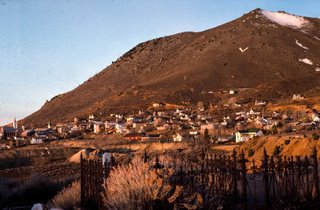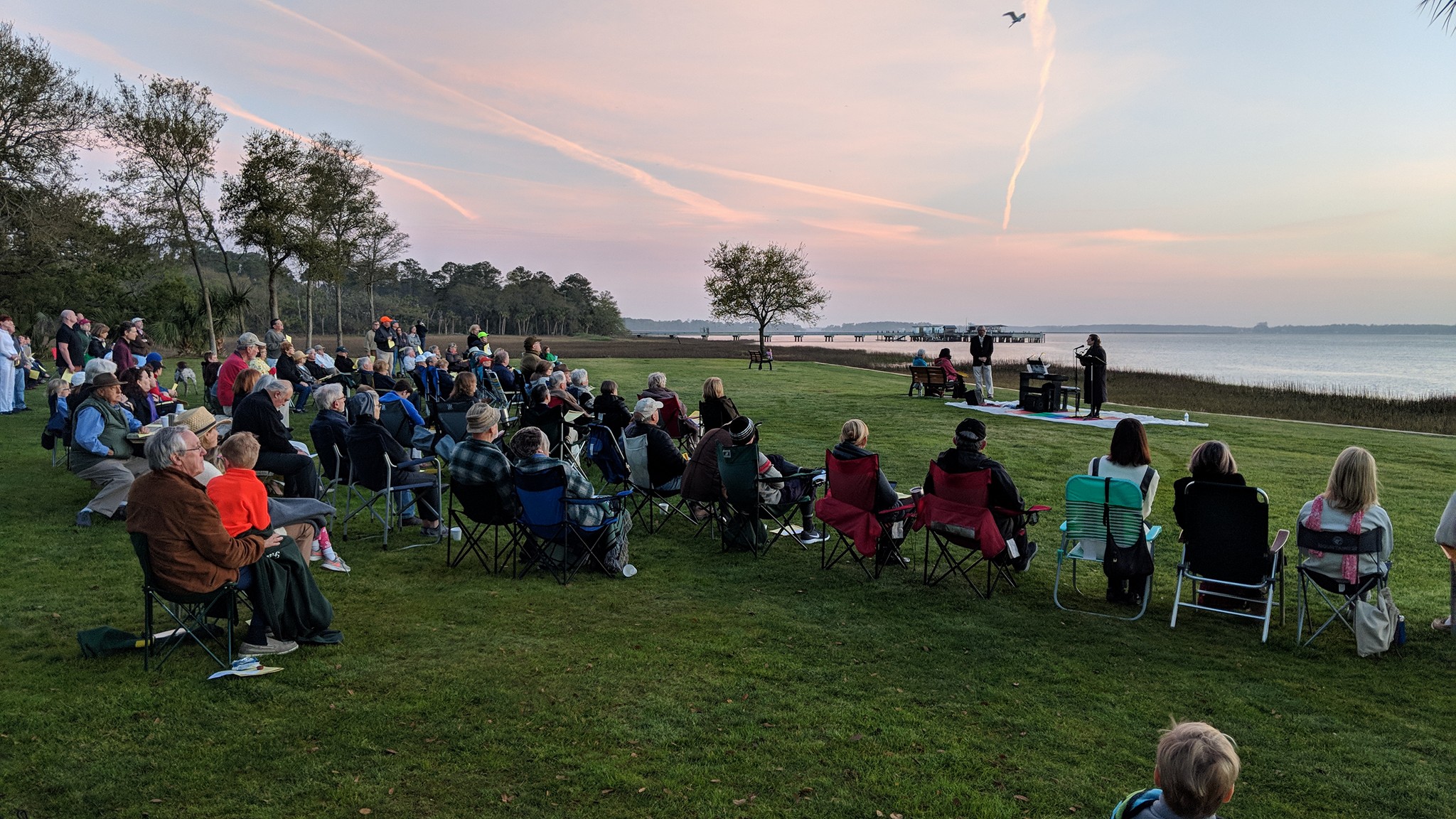Jeff Garrison
Mayberry and Bluemont Churches
Easter Sunday (April 20th) 2025
Mark 16:1-8
At the beginning of worship:
During the Kosovo War, a journalist filed a report about ethnic Albanian deportees in Macedonia. He described the rage experienced by Kosovan professors, writers, and other intellectuals who were robbed not only of their homes but also their books, papers, files—their irreplaceable life’s work. “Can such a deep hurt ever heal?” asked a reporter? Their editor, also an Albanian, then told them a story he’d heard as a child:
There was a naughty boy whose father would hammer a nail into a piece of wood every time his son would do something naughty. One day the boy asked why, and when it was explained, the boy decided he would behave better. Each time he did something good his father would remove a nail from the board. Eventually, all the nails came out…. Yes, the nails were gone,” he said. “But the holes always remained.”[1]
In John’s gospel we’re told Jesus’ wounds remained visible even after the resurrection. Thomas, when he heard Jesus was alive, questioned it and proclaimed that unless he felt the holes in his savior’s hands, he wouldn’t believe. And when Jesus next saw Thomas, he invited him to come forward and stick his finger in the holes of his hands and to place his hand in the side where the spear pierced. Thomas then not only believed, he became the first to declare Jesus to be God.[2]
The resurrected Jesus still had his wounds. So will we, who are wounded in this life. But our wounds will become beautiful. They’re signs of what Paul refers to when he says, “we’ve fought the good fight, finished the race, and kept the faith.”[3] On Easter, let’s remember and celebrate Jesus Christ, the one who leads the way. He’s the one we’re to follow, and who gives us hope for the life and the world to come.
Before reading the Scripture
Today, we’re completing our time in the gospel of Mark by looking at the original ending of the book. Mark ends at Mark 16:8. Mark’s original ending leaves the reader hanging, wondering what happened. It has been well documented that verses 9 to 20 were added much later than the rest of the book.[4]
Throughout the book, Mark focuses on the life of Jesus and that’s true even at the end. Matthew ends with the resurrected Christ giving the commission to the disciples to go out and establish the church. Luke carries on through Acts, showing the early growth of the church. As John’s gospel nears the ends, Jesus insists that Peter tend Jesus’ sheep.[5] In other words, Peter is to take care of those in the church.
Mark, on the other hand, primarily focuses on Jesus, his life and death. I think Mark assumes his audience knows Jesus’ the church has been established. What Mark emphasizes throughout the book is that Jesus is God and, when he comes to the Garden of Gethsemane as we saw last week, also human. While Mark has no nativity story like Matthew and Luke, we do learn the truth of the incarnation. In the life of Jesus, God becomes a man.
Mark provides less details of Jesus’ resurrection than the other gospels. We don’t hear of Jesus appearing to Mary, at least not right away.[6] There’s no race between Peter and John to the tomb.[7] Nor are their guards placed at the door of the tomb to make sure no one takes Jesus’ body.[8] Instead, Mark just gives the bare details and leaves it up to us to interpret. Let’s hear.
Read Mark 16:1-8
Our reading begins after the Sabbath. Jesus’ placement into the tomb came as the sun approached the horizon. Once the sun had set, the Sabbath began. The Hebrew calendar begins with the setting of the sun, not the rising. If any of you have seen Fiddler on the Roof, you’ll remember this. For the period after the sunset through the sunset, nothing that wasn’t necessary was to be done. It was a time of rest and meditation.
When the sun set the next evening, the Sabbath was over. We can imagine at this point; the two Marys and Salome went out as markets opened and purchasing the necessary spices to anoint Jesus body.
Then, as it was already dark, they wait until the next morning. With the sun having risen, they head to the tomb. Mark makes it obvious, these women assumed Jesus was going to be in the tomb and in need of the perfume as his body would have begun to decay. So, just after sunrise, they go to the tomb wondering how they’ll be able to force the stone away from it. But arriving, they realize the stone has already been rolled away. Bravely, they entered the tomb and Jesus is not there. Instead, there is a young man in white (whom we’re left to assume is an angel, a heavenly Messager).
In scripture, angels are always telling people to “Fear not,” which doesn’t seem to do a lot of good for fear naturally arises when we experience something like this. He tells the women not to fear and that Jesus, who was crucified, has now been raised from the dead. He invites them to look at where he’d been laid. At the end of the day, before the Sabbath, the woman had watched as Joseph placed Jesus into his tomb.[9] Now they see he’s gone.
Next, they’re told to tell the disciples and Peter (perhaps Peter is mentioned by name because he had denied Jesus three times the morning of Jesus’ trial) that Jesus will meet them in Galilee.
This is too much for the women for they run out of the temple in terror and amazement, forgetting to tell anyone what they’d seen. Of course, that begs the question, how do we know about Jesus and his resurrection?
Brian Blount, a retired professor from Union Seminary in Richmond, offers an interpretation here that is unique. Brian finds the key in the command to go back to Galilee, where Jesus began his ministry. He sees this important, go back to the beginning, in which Jesus began with the claim that God’s kingdom has come near.[10] And it’s up to the reader to take up the call to preach the good news.[11]
We’re the ones who called to proclaim what God has done for us through Jesus Christ, who died for our sin and who is resurrected, providing us hope in the life to come. The burden of the gospel is shifted to us, to the church, to offer hope to the world.
Over the past sixteen months, I have been preaching through the Gospel of Mark. I did this to encourage you to look seriously at the life of Jesus. We’re all called to follow him and to be his disciples. In Mark, there is a distinction between “the twelve” and the disciples. The 12 are the inner core. But disciples are men and women who follow Jesus. And we’re included in the list of disciples. What have we learned about Jesus from Mark which we should use to mold our lives in his image?
Unlike Luke or John, Mark provides no reason for his gospel. Some have thought that with the Apostles dying, Mark felt it necessary to provide a portrait of Jesus for the Hellenistic or Greek world which surrounded the Mediterranean Sea. This Mark does with his fast pacing, as he captures moments of Jesus’ ministry, even showing Jesus’ irony and how he surprises people.[12]
Others suggested Mark is one long passion narrative with an extended introduction.[13] I see a value in such an understanding, especially since in the early church, to claim the death of your hero as one crucified went against common perception of the cross.[14] Instead of seeing the cross showing the brutal power of Rome to deal with its enemies, real and perceived, the cross becomes the symbol of the church who follows the crucified one.
Finally, as we’ve seen throughout, the gospel is about Jesus. Only two passages in Mark are about anyone else; both are about John the Baptist, whose role was to point to Jesus. And we’re to be about Jesus. As followers of Jesus, we celebrate his resurrection, but we also look to him to see how we should live. Amen.
[1] New York Times, April 26, 1999, as quoted by Fleming Rutledge, The Crucifixion: Understanding the Death of Jesus Christ(Grand Rapids, MI: Eerdmans, 2015), 115.
[2] John 20:24-27.
[3] 2 Timothy 4:7.
[4] I spoke more about the various endings of Mark last Easter. See https://fromarockyhillside.com/2024/03/31/easter-2024/
[5] John 21:15-19.
[6] In the “Longer Ending of Mark,” which was added much later, Jesus does met Mary Magdalene that first day. See Mark 16:9. In verse 8, she flees the tomb. In verse 9, she does go to tell the rest of Jesus’ friends.
[7] John 20:3ff.
[8] Matthew 27:62-66.
[9] Mark 15:40.
[10] Mark 1:14-15.
[11] Brian K. Blount, Go Preach! Mark’s Kingdom Message and the Black Church Today (Maryknoll, NY: Orbis, 1998), 188-189.
[12] James R. Edwards, The Gospel According to Mark (Grand Rapids, MI: Eerdmans, 2002), 12.
[13] Douglas R. A. Hare, Mark: Westminster Bible Companion (Louisville, KY: WJKP, 1996), 7-8.
[14] Robert H. Gundry, in his 1993 commentary on Mark, takes this approach. Hare, 6.

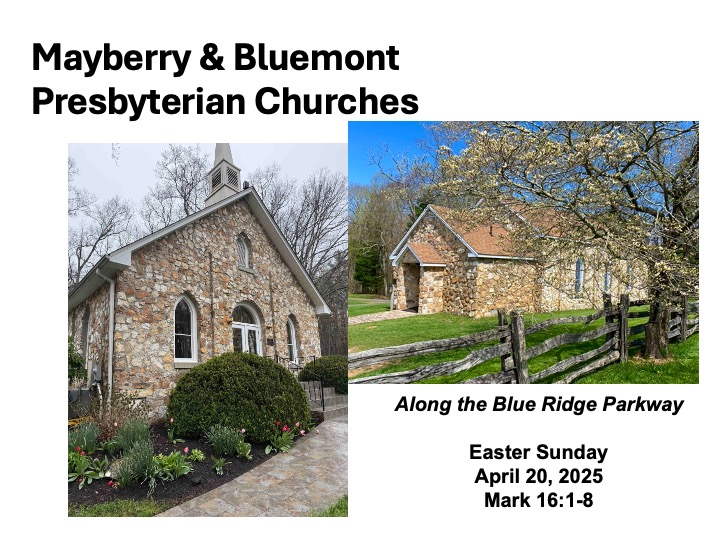

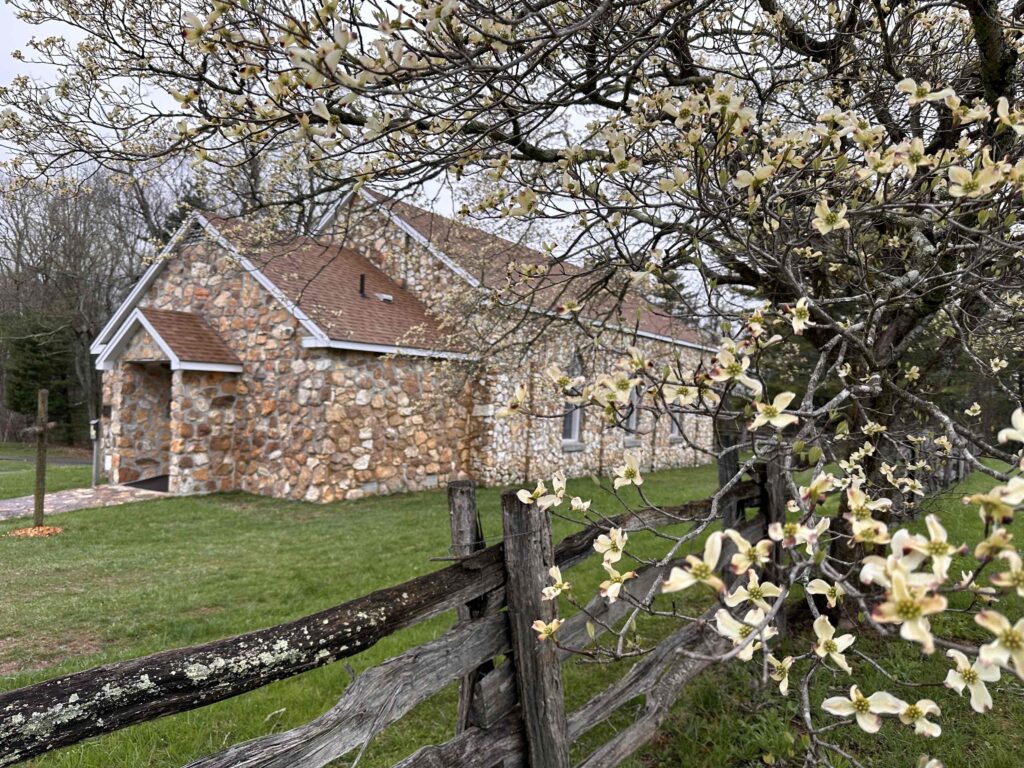
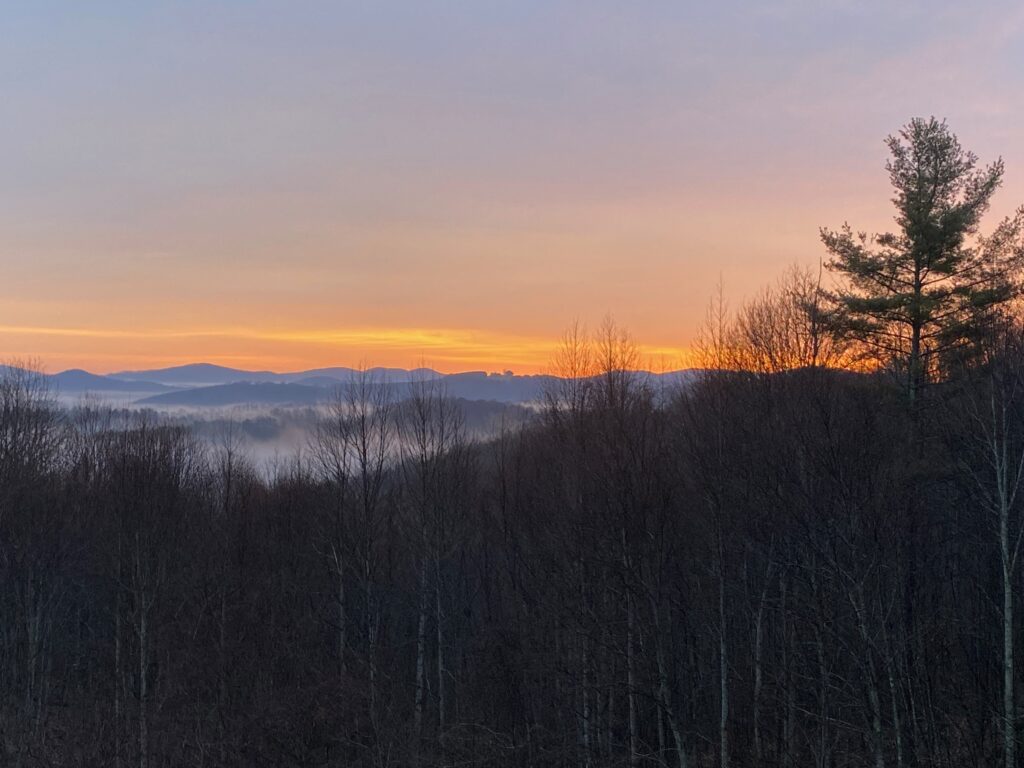
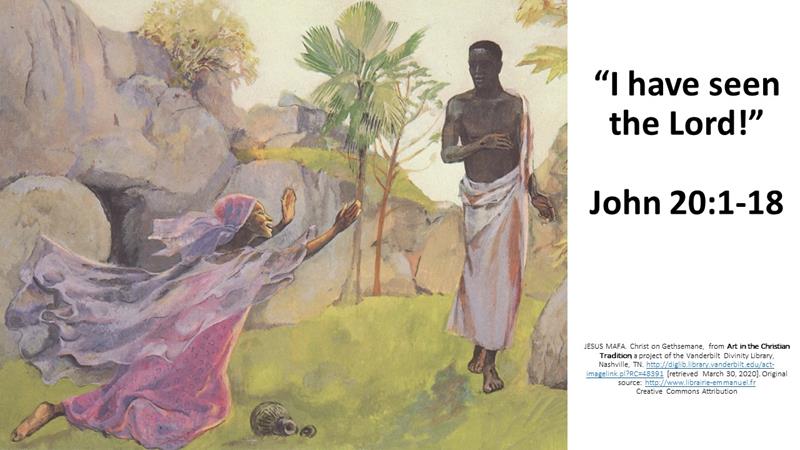
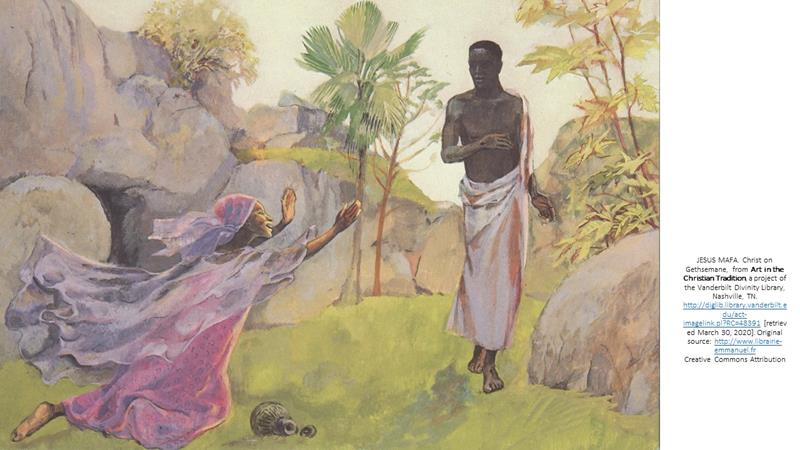 I’ve stuck by Jesus ever since I encountered him that day on the road, long before we came to Jerusalem, when he freed me of those seven demons that had tormented me.
I’ve stuck by Jesus ever since I encountered him that day on the road, long before we came to Jerusalem, when he freed me of those seven demons that had tormented me.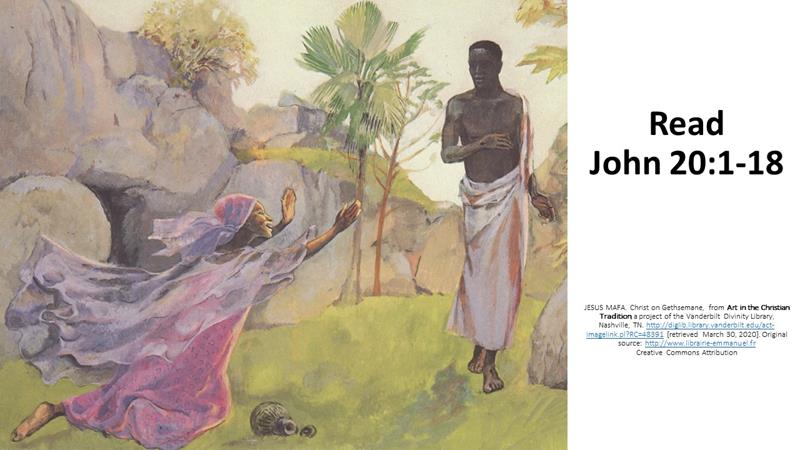
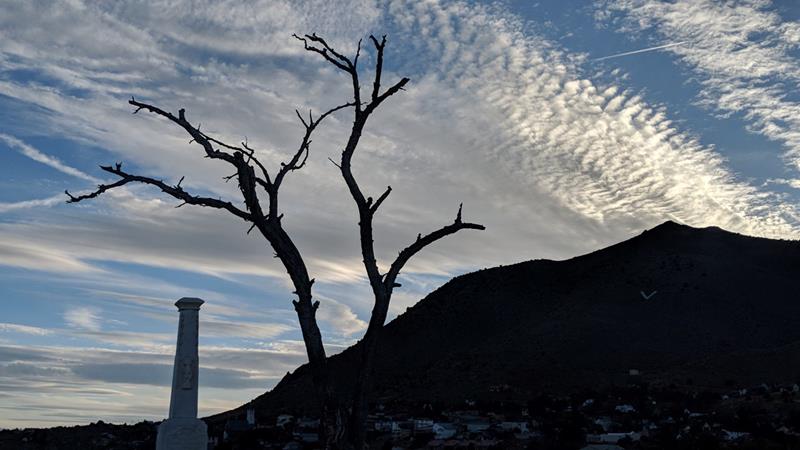 We have spent all of Lent looking at the last week of Jesus’ earthly ministry: From the entry into Jerusalem on what we call Palm Sunday, to the teachings at the temple and the various dinners and then the betrayal that led to Jesus’ death. On Friday, we appeared to be the end of the story. Jesus is dead. His lifeless body is sealed in a tomb as the sun is going down on the day for preparing for the Sabbath. Everyone returns to their homes or where they’ve been staying. I’m sure Caiaphas, the chief priest, and Pilate, the Roman governor, along others in leadership positions are glad to be done with this rabble-rouser. They may have even rested well on the Sabbath. Others, like the disciples and those who had followed Jesus were troubled. But they, too, felt it was over. They saw Jesus’ limp body be taken from the cross. But, as we know, the story doesn’t end.
We have spent all of Lent looking at the last week of Jesus’ earthly ministry: From the entry into Jerusalem on what we call Palm Sunday, to the teachings at the temple and the various dinners and then the betrayal that led to Jesus’ death. On Friday, we appeared to be the end of the story. Jesus is dead. His lifeless body is sealed in a tomb as the sun is going down on the day for preparing for the Sabbath. Everyone returns to their homes or where they’ve been staying. I’m sure Caiaphas, the chief priest, and Pilate, the Roman governor, along others in leadership positions are glad to be done with this rabble-rouser. They may have even rested well on the Sabbath. Others, like the disciples and those who had followed Jesus were troubled. But they, too, felt it was over. They saw Jesus’ limp body be taken from the cross. But, as we know, the story doesn’t end. John begins the 20th Chapter with several statements about time. It’s early. It’s the first day of the week. In the first chapter, John’s gospel has an echo of Genesis. Both start the same way, “In the beginning…” John takes that well-known phrase from the opening chapter of Scripture and applies it to Jesus. Jesus, the Word, was with God at the beginning of creation. God is doing something new. As in the seven days of Creation, when God created heaven and earth, we now have a new week. In the first week of Creation, God created humanity, the crown of creation, on day six. Now, on day six, God once again does his triumphant work, reconciling a sinful humanity with the divine through the sacrifice of God’s Son. That’s Good Friday. God rests on the seventh day, the Sabbath, our Saturday. And then, on the first day of the new week, in those early morning hours, God begins a new age.
John begins the 20th Chapter with several statements about time. It’s early. It’s the first day of the week. In the first chapter, John’s gospel has an echo of Genesis. Both start the same way, “In the beginning…” John takes that well-known phrase from the opening chapter of Scripture and applies it to Jesus. Jesus, the Word, was with God at the beginning of creation. God is doing something new. As in the seven days of Creation, when God created heaven and earth, we now have a new week. In the first week of Creation, God created humanity, the crown of creation, on day six. Now, on day six, God once again does his triumphant work, reconciling a sinful humanity with the divine through the sacrifice of God’s Son. That’s Good Friday. God rests on the seventh day, the Sabbath, our Saturday. And then, on the first day of the new week, in those early morning hours, God begins a new age. As Paul proclaims, Christ is the first fruit of those who died.
As Paul proclaims, Christ is the first fruit of those who died.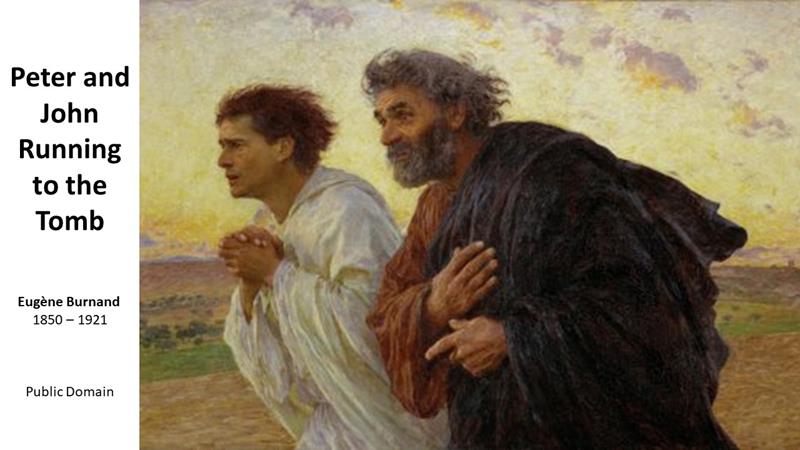 The reports of this new era start with a restless Mary Magdalene going to the tomb while it’s still dark and seeing that it’s open. Of course, her experience, as is ours, is that once you are dead, there’s no coming back. So she runs to tell the disciples. Two of them, Peter and probably John, race each other back to the gravesite.
The reports of this new era start with a restless Mary Magdalene going to the tomb while it’s still dark and seeing that it’s open. Of course, her experience, as is ours, is that once you are dead, there’s no coming back. So she runs to tell the disciples. Two of them, Peter and probably John, race each other back to the gravesite.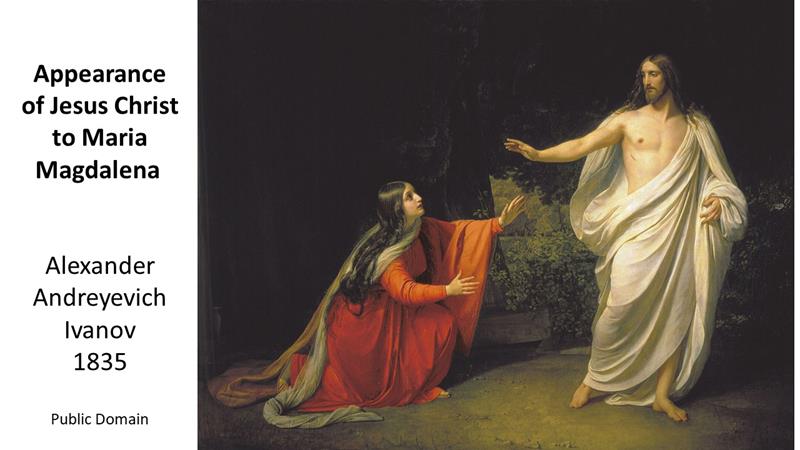 Mary hangs around. We get a sense of what she is thinking when she answers the angels who want to know why she’s crying. “They’ve taken away my Lord, and I don’t know where they laid him.” Mary Magdalene still believes that Jesus is dead. She assumes, because she can’t imagine otherwise, that some grave robber broke into the tomb and took the body away. In her mind, this is a terrible deed. It would be a terrible deed. You don’t mess with dead bodies. Even our military prosecutes soldiers who desecrate enemy dead. After all, once they are dead, they no longer pose a threat and are no longer enemies.
Mary hangs around. We get a sense of what she is thinking when she answers the angels who want to know why she’s crying. “They’ve taken away my Lord, and I don’t know where they laid him.” Mary Magdalene still believes that Jesus is dead. She assumes, because she can’t imagine otherwise, that some grave robber broke into the tomb and took the body away. In her mind, this is a terrible deed. It would be a terrible deed. You don’t mess with dead bodies. Even our military prosecutes soldiers who desecrate enemy dead. After all, once they are dead, they no longer pose a threat and are no longer enemies. This is an Easter unlike any we’ve experienced before. Instead of being together, wearing new clothes, bringing flowers to decorate the cross afterwards while kids hunt Easter eggs, we’re all separated as we strive to stop this virus that has unleashed death upon the earth. In some ways, we’re like the disciples, who were essentially hiding on that first Easter. Yes, Mary was out, as well as Peter and John for a short period, but once they saw Jesus’ body is gone, they head back to where the rest of the disciples are hiding. In fact, if you keep reading, you’ll see the disciples were not only hiding, they were behind locked doors.
This is an Easter unlike any we’ve experienced before. Instead of being together, wearing new clothes, bringing flowers to decorate the cross afterwards while kids hunt Easter eggs, we’re all separated as we strive to stop this virus that has unleashed death upon the earth. In some ways, we’re like the disciples, who were essentially hiding on that first Easter. Yes, Mary was out, as well as Peter and John for a short period, but once they saw Jesus’ body is gone, they head back to where the rest of the disciples are hiding. In fact, if you keep reading, you’ll see the disciples were not only hiding, they were behind locked doors. This is the meaning of this “great pause” we are living through right now.
This is the meaning of this “great pause” we are living through right now. Jeff Garrison
Jeff Garrison 

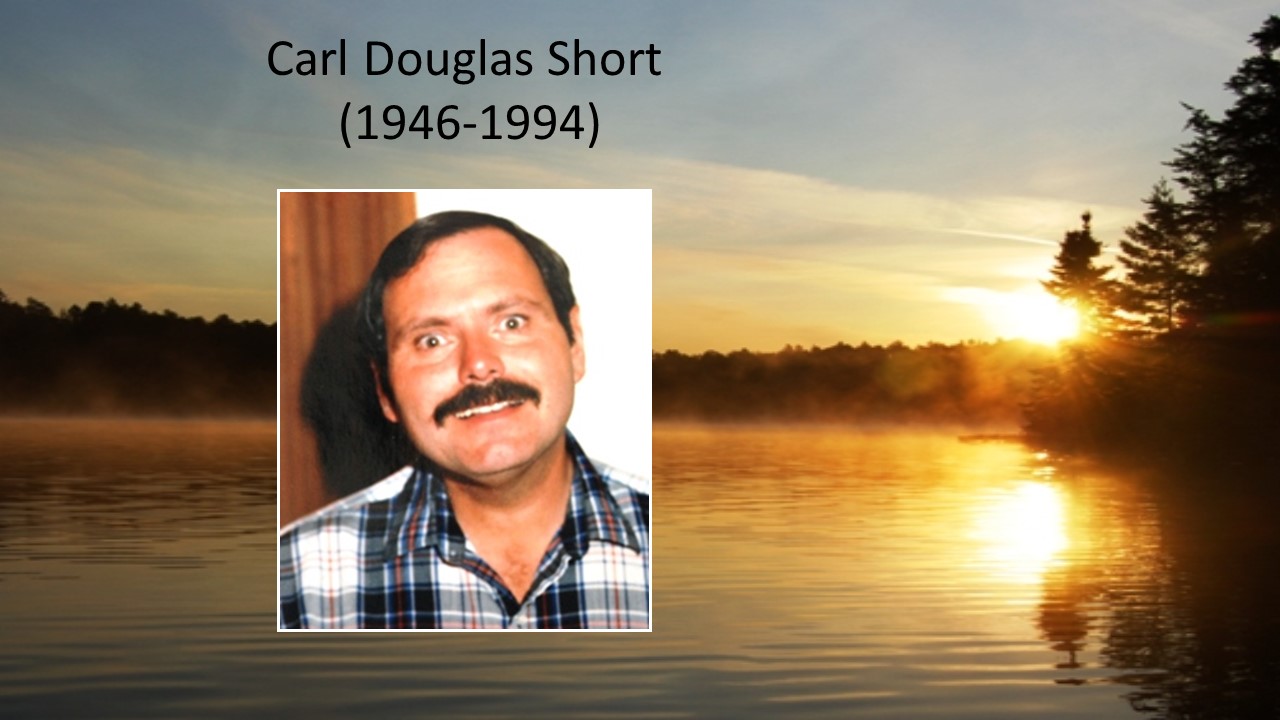 His name was Carl Douglas and he had lived in Virginia City when I was a student pastor there. In the five or so years in between, I’d lost track of Doug, but I had been with him when the doctor had given him the bad news that he had cancer. When I last talked to him, it was in remission, but had come back with a vengeance. I’d been praying for this friend, without knowing it, for months. And now I was sitting across from his estranged sister. Unlike her, I had only good memories of her brother. New Year’s Eve 1988 was one. It was a Saturday and we both had plans for the evening, but when I was in the church practicing my sermon I heard water running and after checking found there was a busted pipe in the heating system, underneath the organ. Doug came right down and we spent a couple of hours fixing the pipe so that we might have heat for Sunday. That was only one example. He was known of his kindness, for being quick to offer a hand to those in need.
His name was Carl Douglas and he had lived in Virginia City when I was a student pastor there. In the five or so years in between, I’d lost track of Doug, but I had been with him when the doctor had given him the bad news that he had cancer. When I last talked to him, it was in remission, but had come back with a vengeance. I’d been praying for this friend, without knowing it, for months. And now I was sitting across from his estranged sister. Unlike her, I had only good memories of her brother. New Year’s Eve 1988 was one. It was a Saturday and we both had plans for the evening, but when I was in the church practicing my sermon I heard water running and after checking found there was a busted pipe in the heating system, underneath the organ. Doug came right down and we spent a couple of hours fixing the pipe so that we might have heat for Sunday. That was only one example. He was known of his kindness, for being quick to offer a hand to those in need. few months after the funeral, Elvira arranged to move back to Nebraska. When I think about all this, I’m amazed. I see God’s hand at work. What was the probability Elvira would end up in a church in a distant city where the pastor knew her son? There was actually a good chance her son could have died and she’d never seen him or even been able to attend the funeral, or even know of his death. Thankfully, she was able to see him and attend his funeral. God enjoys working to bring about surprises and joy!
few months after the funeral, Elvira arranged to move back to Nebraska. When I think about all this, I’m amazed. I see God’s hand at work. What was the probability Elvira would end up in a church in a distant city where the pastor knew her son? There was actually a good chance her son could have died and she’d never seen him or even been able to attend the funeral, or even know of his death. Thankfully, she was able to see him and attend his funeral. God enjoys working to bring about surprises and joy!
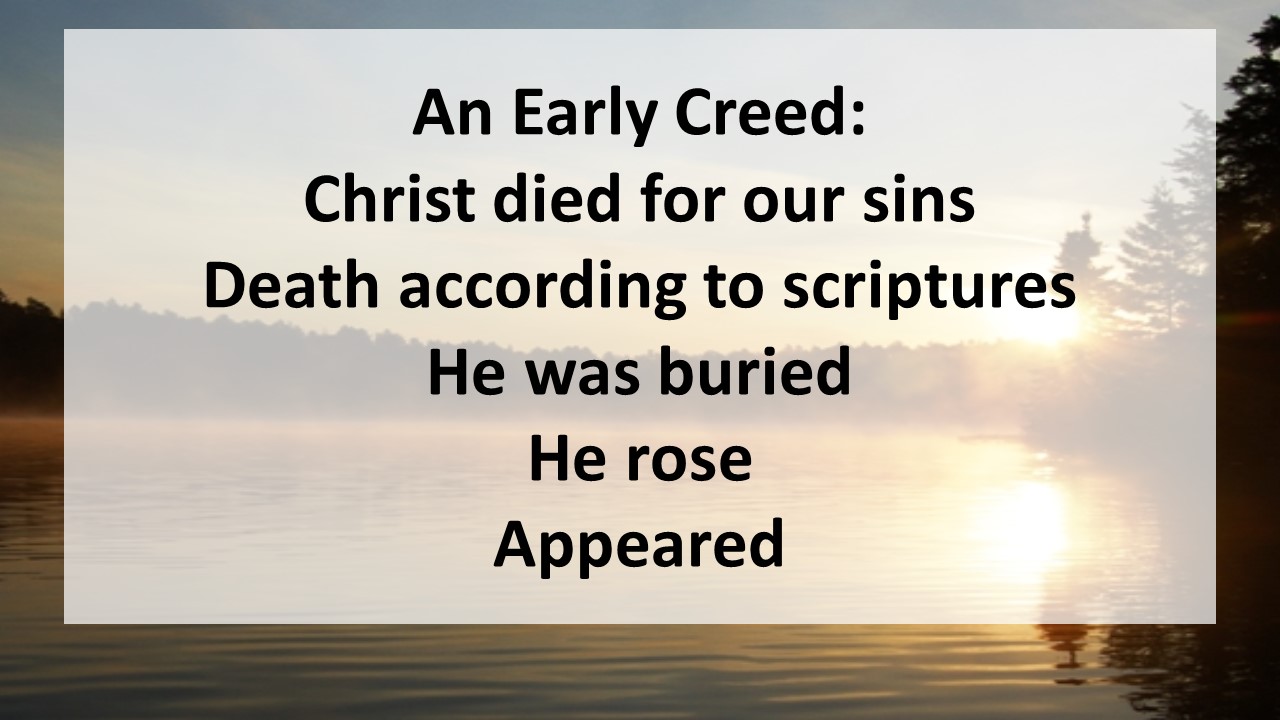

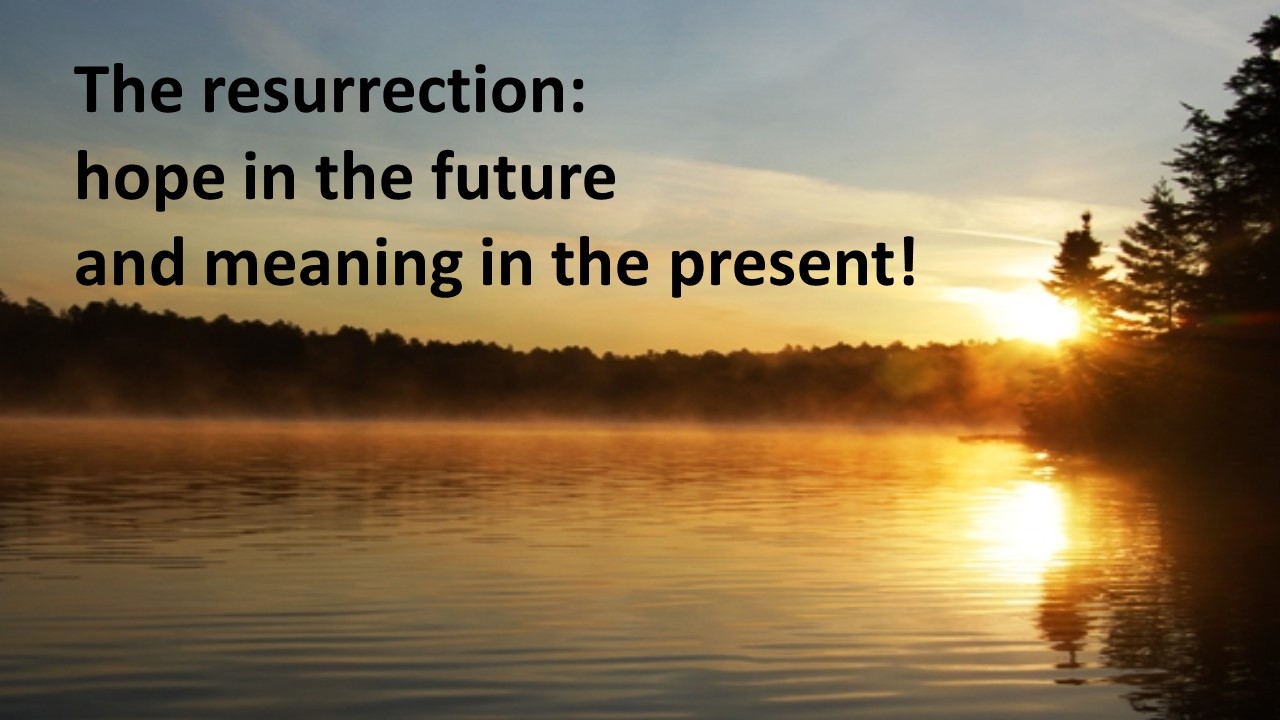 N. T. Wright, an insightful theologian from the British Anglican community says this:
N. T. Wright, an insightful theologian from the British Anglican community says this: In other words, because of the resurrection, we’re now invited to live as God intends as we join God in his work of transforming the world—a transformation that begins with the open tomb on Easter morning. Everything will be changed. Jesus has defeated death and inaugurates the reclamation of the earth for God’s purpose.
In other words, because of the resurrection, we’re now invited to live as God intends as we join God in his work of transforming the world—a transformation that begins with the open tomb on Easter morning. Everything will be changed. Jesus has defeated death and inaugurates the reclamation of the earth for God’s purpose. Will we believe? Will we allow ourselves to be transformed? God is working miracles in this world. I shared one such miracle at the beginning of the sermon. God wants to reconcile the world, not just to himself, but between mother and son, brothers and sisters, friends and enemies. Will we accept God’s invitation to proclaim the good news? Will we accept the invitation to hop up on the bandwagon and follow Jesus, out of the grave and into life? Let us pray:
Will we believe? Will we allow ourselves to be transformed? God is working miracles in this world. I shared one such miracle at the beginning of the sermon. God wants to reconcile the world, not just to himself, but between mother and son, brothers and sisters, friends and enemies. Will we accept God’s invitation to proclaim the good news? Will we accept the invitation to hop up on the bandwagon and follow Jesus, out of the grave and into life? Let us pray:

